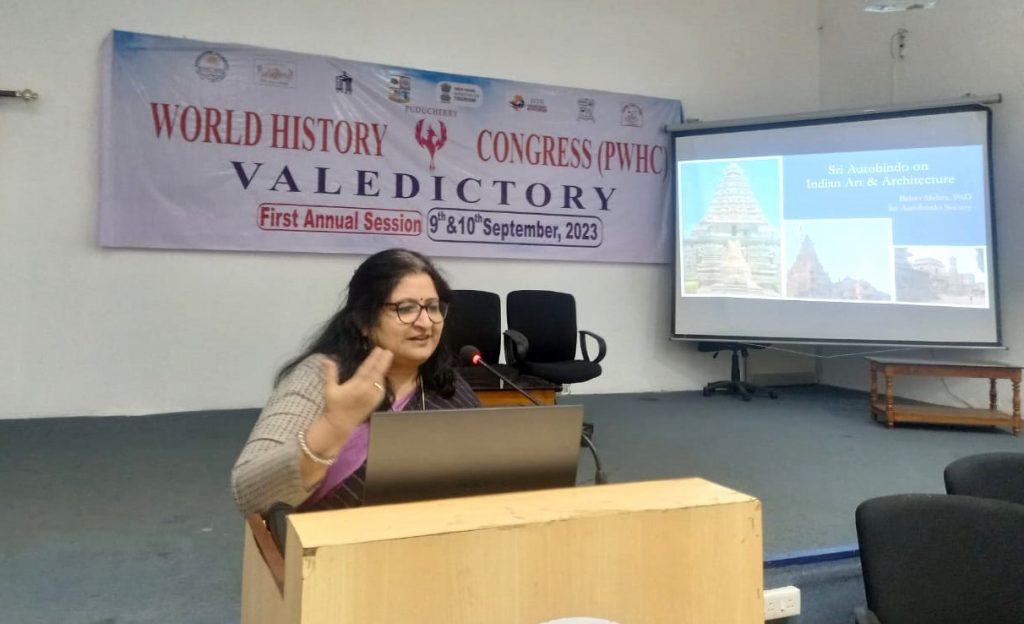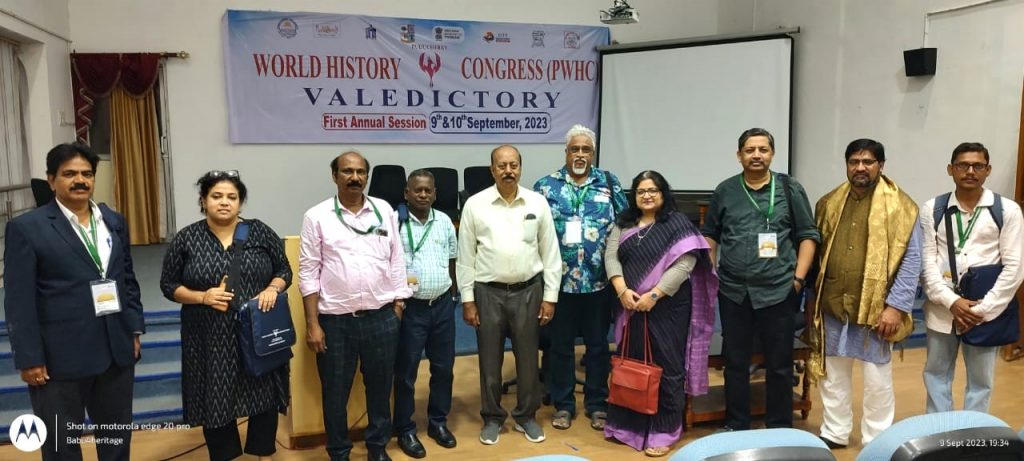Date: September 9, 2023
Venue: Puducherry World History Congress, Pondicherry University
As part of the First Annual Session of the Puducherry World History Congress, hosted by Department of Tourism Studies, Pondicherry University, Dr. Beloo Mehra, Director, BhāratShakti, was invited to present a special lecture on September 9, 2023 on the topic “Sri Aurobindo on Indian Art and Temple Architecture.” Mr. Sivasankar Babu of Tamil Heritage Trust was her co-panelist for the special lecture session, who focused on the Agamic Insights on Temple Architecture.
The session was held at UMISARC Auditorium, Silver Jubilee Campus at Pondicherry University. In her talk Dr. Mehra emphasised that according to Sri Aurobindo Indian art, or at least the highest and best Indian Art has always been identical in its spiritual aim and principle with the rest of Indian culture. She had put together a small presentation with some relevant pictures showing the best of Indian temple architecture and sculptures – almost all of these photographs were taken by her during her travels to various heritage places in India.

According to the Indian aesthetics, the highest purpose of Art is to disclose something of the Self, the Infinite, the Divine to the regard of the soul – the Self through its expressions, the Infinite through its living finite symbols, and the Divine through his powers. But even when it is focused on the material world and outer life, and things of external Nature, Indian art does not altogether get rid of the deeper spiritual seeing.
Sri Aurobindo, said Dr. Mehra, emphasised that soul realisation is method of creation when it comes to the highest Indian art, and soul realisation must be the way of one’s appreciation, response and understanding. Form, for an Indian artist – whether sculptor, painter or architect, does not exist except as a creation of the spirit and draws all its meaning and value from the spirit. This is also true of Indian temple architecture, because it was recognised that an Indian temple, to whatever godhead it may be built, “is in its inmost reality an altar raised to the divine Self, a house of the Cosmic Spirit, an appeal and aspiration to the Infinite.” (Sri Aurobindo, CWSA, 20: 273)

Dr. Mehra briefly highlighted what Sri Aurobindo recommends in terms of fully appreciating and realising the spirit that is being expressed through the form of a temple. “The straight way here is not to detach the temple from its surroundings, but to see it in unity with the sky and low-lying landscape or with the sky and hills around and feel the thing common to both, the construction and its environment, the reality in nature and the reality expressed in the work of Art.”
When understood this way, a temple seems to be “something which has started out and detached itself against the power of the natural world, something of the one common aspiration in both to the same infinite spirit of itself – the inconscient uplook and against it the strong single relief of the self-conscient effort and success of finding.”

She also reminded that another important aspect to deeply appreciate the Indian temple architecture is what Sri Aurobindo speaks of as Oneness of the Infinity and Infinite Multiplicity. Dr. Mehra then briefly spoke on the connection between the great flowering of the art of sculpture in ancient and medieval India and the massive temple building activities that happened in various parts of India. She also spent a few minutes sharing Sri Aurobindo’s key insights on the role of murti-puja in the overall Indian religio-spiritual traditions, and the philosophical root of outer worship.
Dr. Mehra’s talk was highly appreciated by the other invited speakers, scholars and university students.

